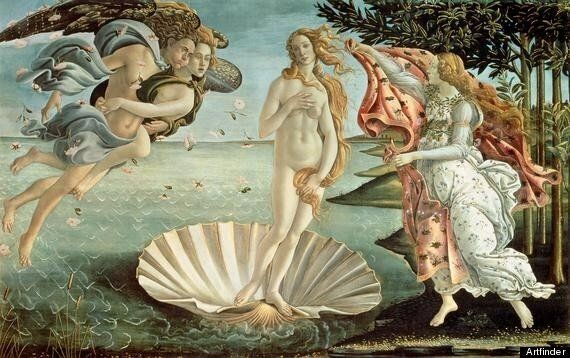
Sandro Botticelli, The Birth of Venus (1485), © Bridgeman Art Library / Galleria degli Uffizi
Venus arrives in style, on a seashell, blown in by a couple of Greek gods.
Ready to dry her off with a flowery towel is Horae, Goddess of the Seasons. Venus covers herself with her long hair, and makes a vague attempt at covering her breasts to stay respectable.
This is arguably Sandro Botticelli’s most iconic painting, and as we commemorate his death this week (17 May, 1510), we are also inspired by the essence of Spring and Summer that characterizes this work.
Venus was the Roman Goddess of love, beauty and fertility - and Botticelli depicts her emerging from the sea as a full-grown woman.
This painting emphasizes her sensuality, her womanhood and her ability to inspire pure love. Venus’ elegantly curving posture reminds us that she embodies an erotic beauty - and in this case her form was inspired by Roman sculptures of the goddess, which depict her as the ideal female form.
She stands in a pose called contrapposto – where most of the weight falls on one leg, and the shoulders are twisted, lying on a different axis from the legs. The body spirals upwards effortlessly, as if in mid motion.
Botticelli of course took some artistic license and never depicted his subjects in a true-to-life way; the painting is flat, Venus’ neck and torso are elegantly elongated, she appears weightless upon the shell, and all perspective is removed.
Botticelli does not ground his figures by using shadows, and minimises strong contrasts of light in a way that flattens his subjects. This gives the painting an ethereal, other-wordly quality; it depicts a more ideal realm where beauty prevails.
You can see that Venus arrives on a seashell, which in classical antiquity was a metaphor for a woman’s vulva, the source of all life. She embodies the hope of renewal that comes with the new seasons - and we like to think that this painting might inspire us to look past the gloomy British summertime and think of more ideal times.
If the sun shines and the seasons bloom in Botticelli’s world, then why not in ours!
Artyfacts:
- Born Alessandro di Mariano Filipepi, Botticelli got his nickname from the word ‘botticello’, meaning ‘small wine cask’.
- Peaks and troughs… In his heyday Botticelli was the most esteemed artist in Italy. In his latter years he slipped into poverty, isolation and mental anguish.
- Following his death, Botticelli was virtually forgotten until he was rediscovered by the Pre-Raphaelites in the early 19th century.